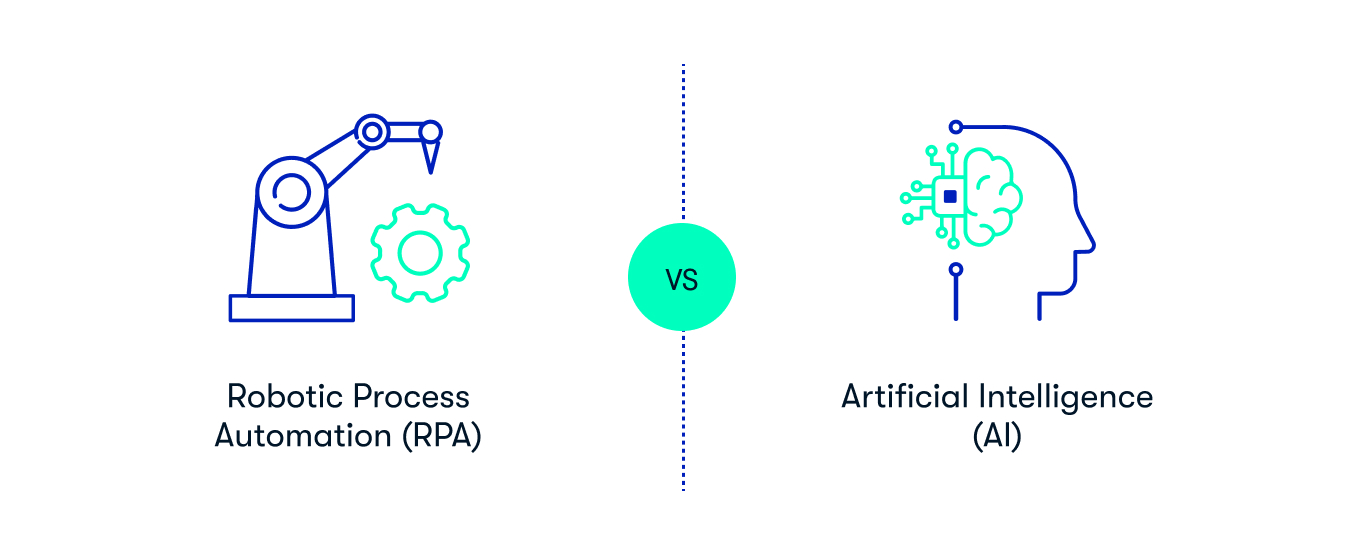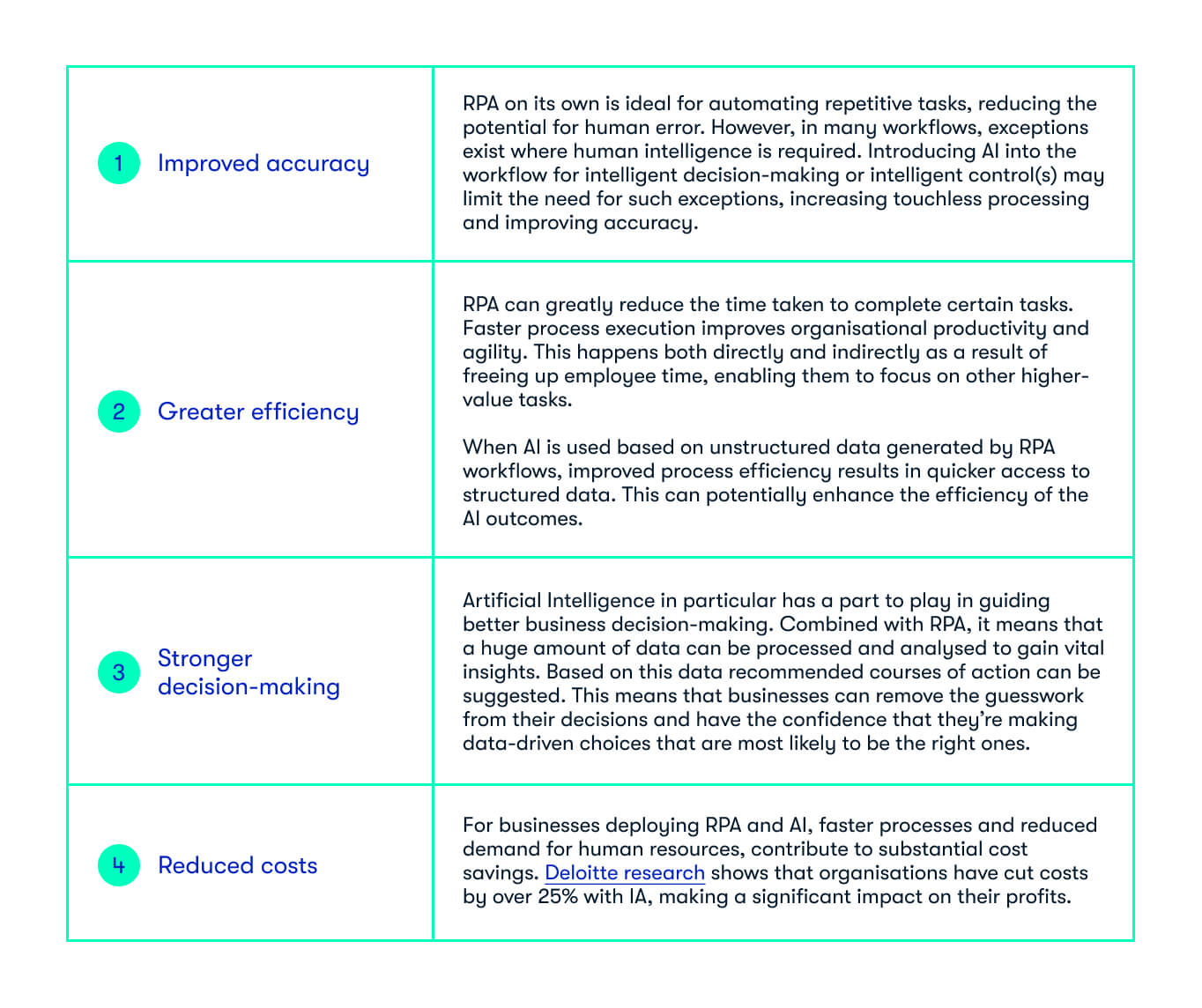How RPA and AI Work Together - Benefits & Use Cases
Key Takeaways:
- RPA helps reduce the cost of process execution.
- Adding AI to RPA enables more discretion where repetitive tasks require it.
- GenAI brings guided creativity into automation where uniqueness is needed.
Investment in Robotic Process Automation (RPA) has been on an upward trajectory since its inception. Along the rise in popularity of Artificial Intelligence (AI), this shows no signs of slowing down.
RPA and AI are two technologies becoming indispensable assets to organisations. According to Goldman Sachs, global investment in AI technologies could hit $200 billion by 2025. A Deloitte survey also reveals that 53% of businesses are actively exploring RPA solutions. An additional 19% plan to do so in the next two years.
Whilst each technology continues to gain traction in its own right, Intelligent Automation (IA) aims to combine these technologies. Using AI in conjunction with RPA will expand and compliment its capabilities and achieve automation objectives with great efficiency and effectiveness.
This blog explores how RPA and AI can be combined as well as the benefits, use cases, and challenges of bringing them together.
How RPA and AI can be combined
First of all, it’s important to establish a clear distinction between RPA and AI. In the rush for businesses to explore these new areas of innovation, it’s important to understand what they mean so you can utilise them effectively.
RPA is how digital workers can execute a business process at high speed and in high volumes, built on rule-based parameters. It’s best suited for relatively simple and linear processes, which are highly repetitive, with limited scope for exceptions. It can also be extremely useful on legacy systems where API integration is not feasible.

AI is a technology that can ‘think’ for itself and therefore, execute more complex processes autonomously. Processes that need certain amounts of analysis or decision-making, gain from the use of AI. As well as those that use considerable volumes of data.
Integrating RPA and AI offers an efficient and simple automation strategy. RPA can handle repetitive tasks while AI can bring in decision-making and analytical capabilities.
In particular, this integrated approach can be used to optimise RPA performance. This includes self-adjusting algorithms, automated auditing and AI-based exception handling. It can also enrich data collection and validation to support AI initiatives.
4 Key Benefits of Combining RPA and AI
When RPA and AI are effectively combined, they can drive digital transformation within an organisation. This includes:

Real RPA and AI use cases
On a more practical level, there is an endless list of possibilities and use cases for Generative AI (Gen AI). When it comes to industries some are more prone to support their processes with the help of Gen AI. We will look at some of the most popular industry-specific use cases of Gen AI:
 Financial Services
Financial Services
By combining RPA's process automation capabilities with AI's data analysis and pattern recognition, financial institutions can achieve higher levels of efficiency, accuracy, and decision-making. These synergies enable them to navigate complex regulatory landscapes and offer more personalised services to customers. Financial institutions also benefit from this as they can adapt better to rapidly changing market conditions.
Mortgage Applicant Processing & KYC:
Companies can first utilise RPA to enhance the efficiency and accuracy of initial data collection, document verification and data entry processes. Afterwards, they can employ AI algorithms to analyse the collected data, evaluate credit risk, and suggest appropriate mortgage options, considering the applicant's financial history and market trends. AI also offers the option to further analyse this information to ensure compliance with KYC regulations, identify potential risks, and provide insights for decision-making.
Investment Portfolio Management:
There are many repetitive administrative tasks within portfolio management, such as rebalancing and transaction execution, that are perfect examples of what should be handled by RPA. AI algorithms can optimise the analysis of market trends, economic indicators, and individual investor preferences. This can be beneficial to businesses as they can gain insights and recommendations for optimising investment strategies.
 Insurance
Insurance
Insurance industry firms can benefit significantly from the combination of RPA and AI to streamline their operational efficiency, customer service, risk assessment, and claims processing.
Policy Renewal and Management:
By examining past claims, customer behaviour and market trends, AI analysis can discover opportunities for policyholders to adjust their coverage or take advantage of discounts. Companies can then use RPA bots to automate policy renewal reminders and premium calculations as these are repetitive manual processes.
Fraud Detection and Prevention:
The same data can also be used for fraud detection, to flag claims that exhibit suspicious characteristics. A more complex analysis can identify complex fraud schemes and enhance the accuracy of detection.
 Retail
Retail
Within retail, a combination of RPA and AI is mainly targeted to enhance customer service and experiences. This includes optimising operations, and improving decision-making to stay competitive in the ever-evolving market landscape.
Inventory Management:
One of the best ways to reduce cost is by managing your inventory efficiently. This can be done through inventory tracking, order processing, and stock replenishment and then integrating your ERP systems with RPA. Using sales data, market trends and external factors like weather forecasts, companies can predict demand, optimize stock levels and prevent overstock or stockouts.
Price Optimisation:
Similarly, to improve the company's revenue stream and stay competitive in the market, it is important to constantly monitor competitors' pricing and update prices across various sales channels using RPA. This can be further enhanced by studying consumer behaviour as well as market conditions to suggest dynamic pricing strategies that maximise revenue.
Challenges and Considerations for RPA and AI
Difficulty Developing an Automation Platform
Creating an integrated automation platform that seamlessly combines and fully utilises RPA and AI capabilities requires careful planning and development. Begin with smaller-scale prototypes to test RPA and AI integration before scaling, collaborating with automation technology vendors for guidance.
Ensuring Responsible AI Implementation
Responsible AI implementation is crucial to avoid ethical, privacy, and security issues. Mitigate risks by choosing verified AI models that have been trained appropriately and prioritise data security. Incorporate human oversight before data transitions and between automated processes to catch errors and ensure ethical decisions. This can be done by incorporating practices or mechanisms that regularly monitor AI performance, logging data for potential issues.
Interdisciplinary Skills, Experience, and Expertise
As always when navigating fresh intricate technologies, one of the biggest hurdles is finding experts in the field. Integrating RPA and AI requires a multidisciplinary approach that combines knowledge of automation technologies, AI algorithms, data analysis, and domain expertise. The most important part of integrating RPA and AI is getting the foundation set up correctly. This can be done by carefully implementing AI into your RPA CoE, or ensuring the right governance if starting from scratch.
The future of RPA and AI
Now is the time to get on board with integrated RPA and AI to maximise the value that RPA can bring to your organisation. With the global excitement around AI that is currently captivating the business world, RPA implementations may be the first step to success.
In a business world that’s more competitive than ever and evolving faster than ever, the future of AI knows no bounds, which means these technologies such as RPA will quickly become essential to keep pace, as long as initially embedded correctly with each other.
Emerging Applications of RPA and AI
One recent and notable combination of RPA and AI is the insertion of GenAI at a specific step in an automation to produce new content relevant to the process. This approach is common in e-commerce communications, such as post-purchase messages and subscription management.
Post-purchase Messages
In a post-purchase message, a basic automation may send a generic "Thank You." However, in pursuit of greater personalization, it might include additional instructions to reference the buyer’s name and the product they bought.
GenAI can enhance this by producing a witty and relevant complement. Say a buyer just got a winter coat and some boots. They can receive a message saying how happy the seller is to know that the buyer will keep warm while looking stylish when winter comes.
GenAI also enables the seller to enhance this message by delivering it with a winter-themed image or as a speech from a staff member in a short video.
Subscriptions
RPA and GenAI can collaborate well in subscription management. Many companies already have automations that display the benefit of signing up or inquire about the reason for unsubscribing. And while some may display an offer (discount) to attract or retain a lead, many lack effective execution.
This may come in the form of written copy that references content in the specific emails the lead opened and clicked through or the pages they've browsed. So, instead of some blanket offer like free shipping on the first purchase, the seller can offer a more meaningful discount on the particular items the lead paid attention to.
GenAI can help craft messages which show that you acknowledge the lead’s unique needs. In fact, ecommerce companies are already seeing massive growth in areas like sign-ups and revenue by using AI to improve the conversion elements of their automated communications.
To learn more about how to deploy RPA and AI for maximum success, Ciklum is here to help. Whatever your industry, our global workforce of more than 4,000 developers and IT leaders can assess your use cases and pinpoint the keys to your ideal deployment. Get in touch with us today to discuss your specifics.



